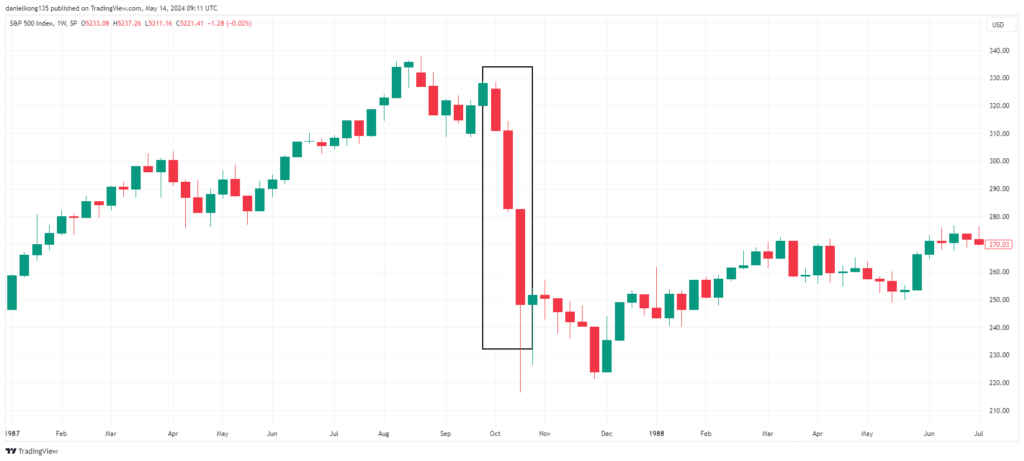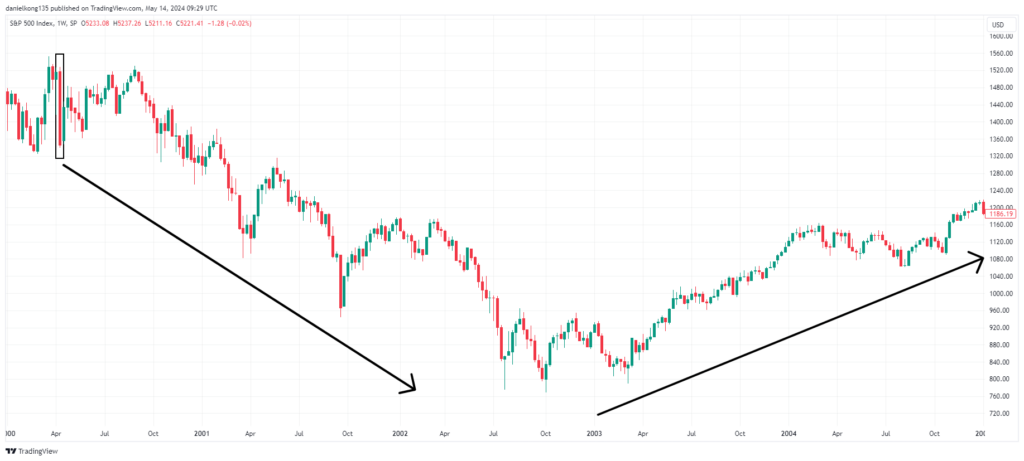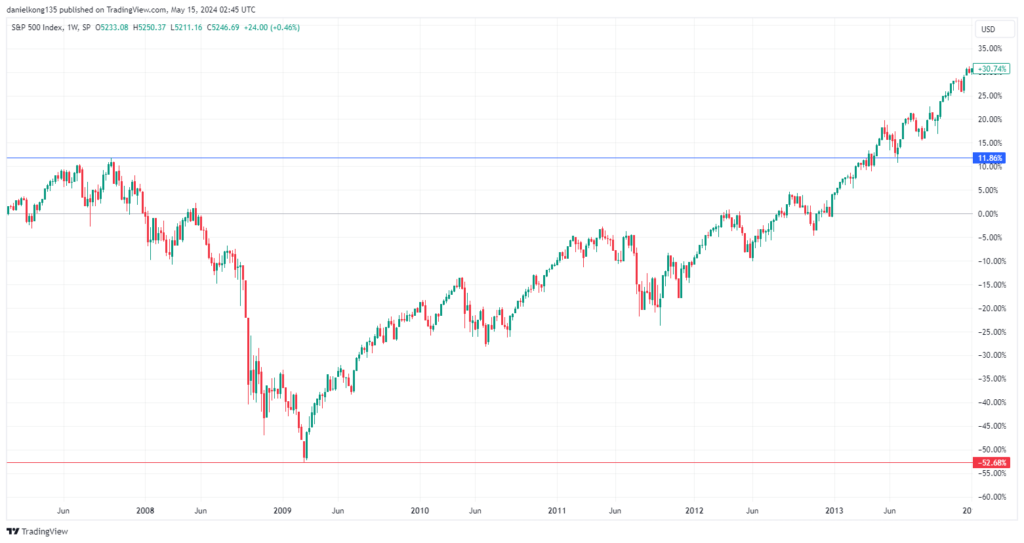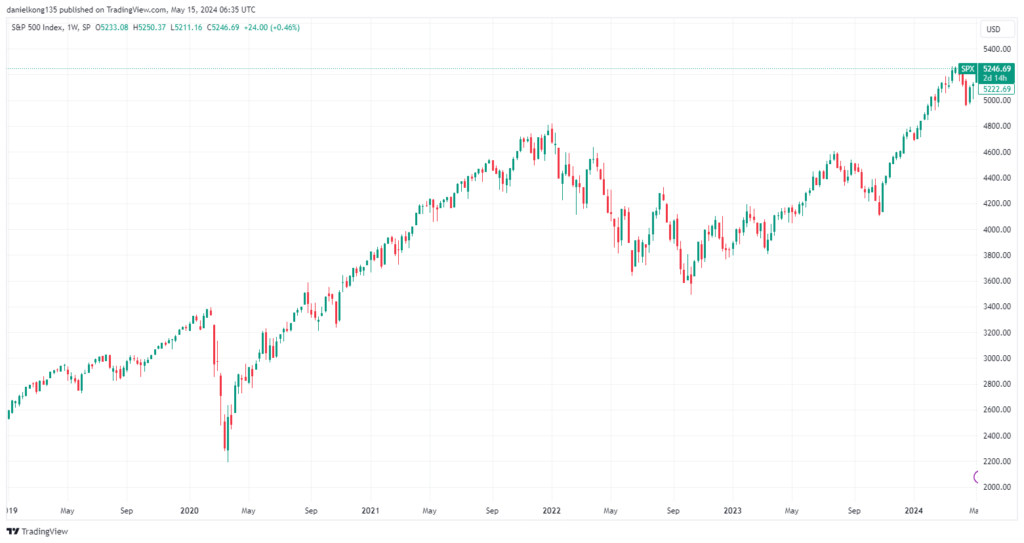The S&P 500 Index, which includes 500 of the largest publicly traded companies in the US, serves as a key barometer for the overall health of the US economy and stock market. Its significance in the financial market is unparalleled, offering insights into market trends and serving as a benchmark for investment performance.
Let’s dive into what the S&P 500 index is, and how you can trade it.
Key Points
- The S&P 500 Index tracks the performance of 500 large US companies, serving as a key indicator of the overall health of the US economy and stock market.
- Trading the S&P 500 offers diversification across multiple sectors, high liquidity, and historical stability, making it a popular choice for both new and experienced traders.
- Effective trading of the S&P 500 requires understanding market analysis techniques, economic indicators, and employing risk management strategies like stop-loss orders and diversification.
What is the S&P 500?
The S&P 500 is an index that tracks the performance of 500 of the largest publicly traded companies in the United States. The index is calculated using a market-cap weighting method, where the total market value of each company is taken into account, giving larger companies more influence on the index’s movements. This method ensures that the S&P 500 accurately reflects the overall health of the US stock market.
Investors and analysts often use the S&P 500 as a benchmark that provides a snapshot of the general market’s performance. They also use it to gauge market trends and compare the performance of individual investments against the broader market due to its comprehensive nature, making it a reliable indicator of the economic strength in the US.
What Companies are in the S&P 500?
At the time of writing, the top 10 constituents of the S&P 500 are as follows [1]:
| Company | Weight (%) |
| Apple Inc | 7.05 |
| Microsoft Corp | 6.54 |
| Amazon Inc | 3.24 |
| NVIDIA Corp | 2.79 |
| Alphabet Inc (GOOGL) – Class A | 2.13 |
| Tesla Inc | 1.95 |
| Alphabet Inc (GOOG) – Class C | 1.83 |
| Berkshire Hathaway Inc – Class B | 1.83 |
| Meta formerly Facebook – Class A | 1.81 |
| UnitedHealth Group | 1.28 |
The index includes market leaders from technology, healthcare, finance, consumer goods, and more, reflecting the diverse makeup of the US economy. This broad representation makes the S&P 500 an all-encompassing gauge of overall market performance and economic health.
Among the top holdings in the S&P 500 are some of the most influential companies in the world, particularly from the technology sector. Tech giants like Apple, Microsoft, Amazon, and NVIDIA lead the index due to their large market capitalisation.
In addition to these big tech names, the top 10 constituents also include diversified powerhouses like Berkshire Hathaway and healthcare leader UnitedHealth Group, highlighting the index’s broad sector representation and its role as a comprehensive indicator of market performance.
Trading hours of the S&P 500 Index [2]
The S&P 500 index follows the trading hours of the New York Stock Exchange (NYSE).
- Mondays to Fridays
- 9.30 am to 4.00 pm
- Extended trading hours
- Pre-market: 4:00 am to 9:30 am
- After hours: 4:00 pm to 8:00 pm
The exchange is closed on Saturdays and Sundays, as well as these ten national holidays:
- New Year’s Day
- Martin Luther King, Jr. Day
- Presidents’ Day
- Good Friday
- Memorial Day
- Juneteenth National Independence Day
- Independence Day
- Labour Day
- Thanksgiving Day
- Christmas Day
Why Trade the S&P 500?
Here are several reasons to trade the S&P 500:
1. Diversification
Trading the S&P 500 provides immediate diversification across a wide range of sectors. This index includes companies from technology, healthcare, finance, consumer goods, and more, giving traders exposure to various segments of the US economy.
With diversified exposure to different industries, this can help traders reduce the risk associated with individual stocks because gains in some sectors can offset losses in others.
Learn all about using index CFDs as a portfolio diversification tool with our comprehensive article.
2. Liquidity
The S&P 500 is one of the most widely followed indices in the world, which translates to high liquidity.
High liquidity ensures that you can enter and exit positions swiftly, allowing for better execution of trades and the ability to react quickly to market changes. This enables you to manage your investments more dynamically and take advantage of market opportunities as they arise.
3. Historical Performance
Historically, the S&P 500 has provided solid returns for investors. Since its adoption of 500 stocks into the index, the average annualised return in 1957 through 31 December 2023, is 10.26% [3]. This historical performance, combined with the index’s stability, makes it a popular choice for both new and experienced traders, offering a blend of growth potential and security.
4. Accessibility
Investing in the S&P 500 is highly accessible through various financial instruments such as ETFs (Exchange-Traded Funds) and index funds. These instruments are available on major stock exchanges and can be traded just like individual stocks. This ease of access makes it convenient for both retail and institutional investors to participate in the market and gain exposure to the 500 largest US companies.
Historical Trends of S&P 500
The S&P 500 has experienced several significant historical trends, each shaping the market in unique ways. In this section, we will break down these trends into each significant event to better understand their impact.
Black Monday [4,5]

In the lead-up to Black Monday 1987, the Dow Jones Industrial Average (DJIA) surged by 44% in seven months, creating fears of an asset bubble. In mid-October, negative news about a larger-than-expected trade deficit and a falling dollar shook investor confidence, leading to significant market losses. The situation worsened on October 16 with the simultaneous expiration of options and futures contracts, known as “triple witching.” Panic spread globally, and on 19 October 1987, the stock market experienced a crash as shown in the chart above.
The crash, primarily driven by programmatic trading and investor panic, wiped out the previous year’s gains in a matter of hours. Quick intervention by the US Federal Reserve, including immediate rate cuts and liquidity measures, helped stabilise the markets over the following weeks. This event served as a stark reminder of market vulnerabilities and the need for effective regulatory measures.
In the chart above, it depicts the S&P 500’s performance from January 1987 to July 1988, highlighting the dramatic drop during Black Monday in October 1987. The marked area shows a sharp decline, where the index fell over 20% in a single day, reflecting the market crash’s severity. Following the crash, the chart shows a period of volatility and gradual recovery over the subsequent months.
Dot-com bubble [6]

The dotcom bubble, also known as the Internet bubble, occurred from 1998 to 2000, driven by speculative investing, an influx of venture capital, and widespread adoption of the Internet. In the late 1990s, investors eagerly poured money into Internet startups, hoping to capitalise on the booming tech sector. Companies, even those without viable business models, received significant funding, leading to rapid growth and inflated valuations.
The bubble was marked by excessive spending on marketing and rapid expansion without regard to profitability. Many startups went public with little to no revenue, relying on the hype surrounding the Internet. The bubble reached its peak in early 2000, with the stock market indices such as the Nasdaq doubling in value over the previous year. However, as capital began to dry up and companies failed to deliver on their promises, the market started to collapse. By March 2000, leading tech companies began to place massive sell orders, triggering panic selling and a sharp decline in the stock market.
This chart illustrates the S&P 500’s performance from January 2000 to December 2004, highlighting the impact of the dot-com bubble crash. The marked area shows the index plummeting in April 2000 as the bubble burst. The index experienced a sharp decline from early 2000, continuing its downward trend until late 2002 as the bubble burst. Following this period, the market began a gradual recovery, marked by consistent gains over the subsequent years. By 2003 and 2004, the S&P 500 showed significant recovery, reflecting a robust resurgence in market confidence and stability.
Financial crisis of 2007–2008 (The Great Recession) [7,8,9]

The Financial Crisis of 2007-2008, known as the Great Recession, was a severe economic downturn caused by a housing market collapse. The widespread issuance of subprime mortgages created a housing bubble, and when it burst, major financial institutions failed. This led to massive job losses, foreclosures, and a sharp decline in the stock market. Government interventions, such as the Troubled Asset Relief Program (TARP), helped stabilise the financial system and initiate recovery efforts.
A major event during this crisis was the collapse of Lehman Brothers in September 2008. Lehman Brothers, one of the world’s largest investment banks, declared bankruptcy due to heavy exposure to subprime debt. This was the largest bankruptcy in US history and triggered a global financial panic. Lehman’s stock plunged 93% between the close of trading on 12 September 2008, and the day it declared bankruptcy.
The chart above shows the S&P 500’s performance from January 2007 to December 2014, highlighting the period during the Great Recession and its aftermath. The index fell by 57% between 2007 and 2009 during this volatile period. As shown in the chart, it took approximately four years to recover from its lowest point in March 2009 before exceeding the highs of 2007 in April 2013.
The S&P 500 in 2021-2024

This chart illustrates the S&P 500’s performance from January 2019 to April 2024. In early 2020, the index experienced a sharp decline due to the COVID-19 pandemic, which caused global economic disruptions and a rapid sell-off in markets.
However, following the initial panic, the S&P 500 began to recover as governments and central banks implemented stimulus measures and vaccine rollouts started, leading to renewed investor confidence. By mid-2020, the index had regained much of its lost ground, and continued its upward trend into 2021.
After the recovery, the S&P 500 entered a period of sideways movement, reflecting market uncertainty and consolidation. This phase lasted until the end of 2023, when the index rallied. Improved economic conditions, heightened market confidence, strong corporate earnings from companies like Nvidia, and signals from the Federal Reserve about potential future rate cuts all contributed to driving the market higher.
By 2024, the S&P 500 had reached new all-time highs of 5,254.35 on 28 March 2024 , showcasing the market’s resilience and investor optimism about the future [10].
How to Trade S&P 500?
Traders can trade the S&P 500 through various financial instruments, each offering unique advantages and risks. Here are a few methods to trade the S&P 500:
Trade the S&P 500 Index with CFD
CFDs allow traders to speculate on the price movements of the S&P 500 index without physically owning the underlying assets. By using CFDs, you can open a position based on whether you think the index will rise or fall, making returns from the difference in price.
This method provides flexibility and the potential for leveraged trades, which can amplify both gains and losses. CFDs also enable traders to take both long and short positions, offering opportunities to profit in various market conditions.
Trade the S&P 500 ETFs with CFD
Trading the S&P 500 ETFs with CFDs combines the benefits of ETFs and the flexibility of CFDs. ETFs represent a basket of stocks that mimic the performance of the S&P 500, and by trading them through CFDs, you can speculate on the ETF’s price movements without owning the actual shares.
Analysing the S&P 500 Market
To effectively trade the S&P 500, it’s crucial to understand both fundamental and technical analysis. Fundamental analysis involves evaluating economic indicators, company financials, and broader economic conditions to determine the intrinsic value of the index. This approach looks at factors such as GDP growth, unemployment rates, corporate earnings reports, and interest rates to predict market trends.
On the other hand, technical analysis focuses on statistical trends from trading activity, such as price movements and trading volumes. This method uses charts and technical indicators to forecast future price movements based on historical data. Both forms of analysis provide valuable insights that can help traders make informed decisions about entering or exiting positions in the S&P 500.
Fundamental Analysis
Fundamental analysis of the S&P 500 involves examining the underlying economic factors that influence the overall market. This includes analysing macroeconomic indicators like GDP growth, inflation rates, and employment data, which provide a snapshot of the economic health.
Additionally, corporate earnings reports and financial statements of the constituent companies are scrutinised to assess their performance and potential for growth. Interest rates set by the Federal Reserve also play a critical role, as they impact borrowing costs and consumer spending.
Technical Analysis
Technical analysis of the S&P 500 focuses on historical price movements and trading volumes to predict future market behaviour. Traders use charts and technical indicators such as moving averages, relative strength index (RSI), and MACD (Moving Average Convergence Divergence) to identify trends and potential reversal points.
This method relies on the idea that past trading activity can give clues about future price movements. Patterns such as head and shoulders, double tops, and triangles are studied to anticipate market direction. Technical analysis helps traders make decisions on entry and exit points, manage risks, and develop trading strategies based on quantitative data rather than market sentiment or economic fundamentals.
Understanding S&P 500 Market Factors
Understanding the various factors that influence the S&P 500 is essential for successful trading and investment.
Economic data
Economic data plays a crucial role in shaping the S&P 500. Key indicators include:
- GDP Growth: This measures the overall health and productivity of the economy. A growing GDP indicates a thriving economy, which can positively impact the stock market, including the S&P 500.
- Interest Rates: Set by the Federal Reserve, these rates influence borrowing costs and consumer spending. Lower interest rates can stimulate economic activity by making loans cheaper, while higher rates can slow down spending and investment.
- Inflation: This measures the rate at which prices for goods and services rise. Moderate inflation suggests a growing economy, but high inflation can erode purchasing power and negatively impact consumer behaviour and corporate profits.
Monitoring these factors helps investors predict market trends and make informed decisions.
Corporate earnings
The performance of major companies listed in the S&P 500 significantly impacts the index. Corporate earnings reports provide insights into a company’s profitability and growth potential. Strong earnings from major companies can drive the index higher, while disappointing results can lead to declines.
For instance, after Nvidia announced its earnings report, its share price surged from $674.72 to $785.38 on 22 February 2024. This helped propel the S&P 500 to a record high, with the index gaining 105.23 points or 2.11% to close at 5,087.03 on the same day [11].
Global market sentiment
Global market sentiment significantly influences the S&P 500, driven by factors such as risk appetite, currency fluctuations, and geopolitical events.
- Risk Appetite: When investors are optimistic about the global economy, they are more inclined to invest in stocks, which drives the S&P 500 higher. Conversely, during times of uncertainty or fear, investors tend to pull back from equities and seek safer investments like bonds or gold, causing the index to drop.
- Currency Fluctuations: Changes in exchange rates can impact multinational companies’ profitability, which in turn affects their stock prices. For instance, a stronger dollar can make U.S. exports more expensive and reduce overseas revenue, negatively impacting the S&P 500. On the other hand, a weaker dollar can boost exports and enhance profits, benefiting the index.
- Geopolitical Events: Events such as trade wars, political instability, and international conflicts can create volatility in global markets. Positive developments, like the resolution of trade disputes or stable political environments, can boost investor confidence and lift the S&P 500. In contrast, adverse events can heighten uncertainty and risk, leading to market sell-offs.
Specific industry trends
The performance of key sectors within the S&P 500, such as technology and financials, can significantly influence the index. For instance, strong growth in the technology sector can boost the overall market, given the large market cap of tech companies. Similarly, trends in industries like healthcare, energy, and consumer goods play a role in shaping the index’s performance. Tracking these industry trends helps investors make sector-specific investment decisions.
Trading Strategies of S&P 500
Explore various trading strategies designed specifically for navigating the S&P 500, accommodating different trading styles and time frames.
Short-Term Trading
Short-term trading strategies are tailored for those who prefer to capitalise on rapid price movements within a brief period. These strategies typically involve a proactive approach to trading, requiring active market engagement and a readiness to react swiftly to market changes.
Day Trading
Day trading the S&P 500 involves entering and exiting trades within the same trading day. Traders avoid holding positions overnight, thereby sidestepping the risks associated with after-hours market fluctuations that could adversely affect trade outcomes.
This strategy focuses on exploiting short-lived market moves during trading hours, aiming to accumulate small gains that contribute to a significant return over time. It demands a high level of discipline and quick decision-making to take advantage of minute-to-minute price changes.
News Trading
News trading as a short-term strategy involves making trades based on news events that have the potential to move the S&P 500 market significantly. Traders employing this strategy must be adept at quickly interpreting news releases and economic indicators that can impact market sentiment and, consequently, stock prices. The key is to anticipate how the market will react to news and to execute trades before these reactions are fully realised by the broader market.
Mid-Term Trading
Mid-term trading strategies cater to those who prefer to capitalise on market trends that unfold over weeks to months. This approach is less about the immediate fluctuations of day trading and more about recognizing and riding the waves of longer market movements, balancing the need for significant returns with manageable risk exposure.
Swing Trading
Swing trading within the context of the S&P 500 involves identifying potential price movements and establishing trades that capitalise on these forecasts. Swing traders focus on capturing the “swing” or the bulk of a price move in either direction, entering trades at the start of a potential price increase or decrease and exiting when the movement is deemed to have run its course.
This strategy hinges on the ability to accurately predict trends and requires a robust understanding of market indicators and chart patterns. Traders utilise a variety of technical analysis tools to help identify these key entry and exit points, including moving averages, relative strength indicators, and volume measurements.
Long-Term Trading
Long-term trading strategies are ideal for investors who prefer a “buy and hold” approach, focusing on the potential for substantial returns over extended periods. This method suits those looking to invest in the S&P 500 through a less hands-on, yet well-thought-out strategy that leverages the overall growth trajectory of the market.
Long-term traders often base their decisions on fundamental analysis, considering the economic factors and corporate performance metrics that indicate sustained growth potential.This strategy does not require constant market monitoring but does call for periodic reviews to adjust holdings in response to significant changes in market conditions or in the fundamental outlook of the investments.
However, as the S&P 500 cannot be owned directly, investors will need to invest in index funds to carry out their long-term strategies. Some popular ETFs that aim to replicate the performance of the S&P 500 include:
- SPDR S&P 500 ETF Trust (SPY)
- Vanguard S&P 500 ETF (VOO)
- iShares Core S&P 500 ETF (IVV)
When selecting an S&P 500-tracking ETF, it’s important to consider the expense ratio, which is the fee imposed by the fund managers. The higher the expense ratio, the more it could eat into your potential profits.
Risk Management Strategy
Effective risk management is essential for trading the S&P 500, protecting traders from significant losses and ensuring long-term sustainability. Here are a few key strategies to manage risk effectively:
- Stop-Loss Orders: Set automatic stop-loss orders to close out positions at a predefined loss level, preventing catastrophic financial impacts from unfavourable market shifts.
- Take-Profit Orders: Implement take-profit orders to lock in gains by automatically closing positions once a target profit level is achieved, securing profits against subsequent volatility.
- Diversification: Spread investments across different indices or other ETFs tracking different indices to mitigate risks associated with specific industry downturns and reduce overall portfolio volatility.
- Leverage Management: Use leverage cautiously. While it can increase potential returns, improper use can also magnify losses substantially.
- Continuous Education: Stay informed about market changes and evolving risk factors. Ongoing learning is crucial to adapt trading strategies to new information and conditions.
- Emotional Control: Maintain discipline in trading decisions. Emotional management helps avoid impulsive trades based on short-term market movements and ensures adherence to planned risk management strategies. Read more about the basics of trading psychology.
Start Trading the S&P 500 CFD with Vantage
Trade the S&P 500 with CFDs to potentially benefit from the dynamic US stock market without direct ownership of underlying fund units or company shares. Enjoy tight spreads and low costs with Vantage, starting from $0 per trade.
Enjoy the flexibility to open long or short positions, and manage risk effectively with tools like negative balance protection, price alerts, and stop losses. With real-time news alerts on our mobile app and trading platform, you have the capabilities to react quickly to market developments and trade on the go.
Sign up for a live account and experience the Vantage advantage today.
References
- “The Top 25 Stocks in the S&P 500 – Investopedia”. https://www.investopedia.com/ask/answers/08/find-stocks-in-sp500.asp. Accessed 14 May 2024.
- “Holidays & Trading Hours – NYSE”. https://www.nyse.com/markets/hours-calendars. Accessed 14 May 2024.
- “S&P 500 Average Return and Historical Performance – Investopedia”. https://www.investopedia.com/ask/answers/042415/what-average-annual-return-sp-500.asp#citation-10. Accessed 14 May 2024.
- “Stock Market Crash of 1987 – Federal Reserve History”. https://www.federalreservehistory.org/essays/stock-market-crash-of-1987. Accessed 14 May 2024.
- “What Caused Black Monday, the 1987 Stock Market Crash? – Investopedia”. https://www.investopedia.com/ask/answers/042115/what-caused-black-monday-stock-market-crash-1987.asp. Accessed 14 May 2024.
- “Dotcom Bubble Definition – Investopedia”. https://www.investopedia.com/terms/d/dotcom-bubble.asp. Accessed 14 May 2024.
- “Great Recession – Britannica Money”. https://www.britannica.com/money/great-recession. Accessed 15 May 2024.
- “Great Recession: What It Was and What Caused It – Investopedia”. https://www.investopedia.com/terms/g/great-recession.asp. Accessed 15 May 2024.
- “The Collapse of Lehman Brothers: A Case Study – Investopedia”. https://www.investopedia.com/articles/economics/09/lehman-brothers-collapse.asp. Accessed 15 May 2024.
- “Dow and S&P 500 end at records, post best two-quarter gains since 2020 – MarketWatch”. https://www.marketwatch.com/livecoverage/stock-market-today-dow-futures-dip-ahead-of-long-weekend/card/dow-and-s-p-500-end-at-records-post-best-two-quarter-gains-since-2020-WsRsh8pqr1fMKCGa9IrH. Accessed 15 May 2024.
- “S&P 500, Dow surge to record closing highs as Nvidia sparks AI frenzy – Reuters”. https://www.reuters.com/markets/us/nasdaq-futures-jump-nearly-2-after-nvidia-trounces-expectations-2024-02-22/. Accessed 15 May 2024.



